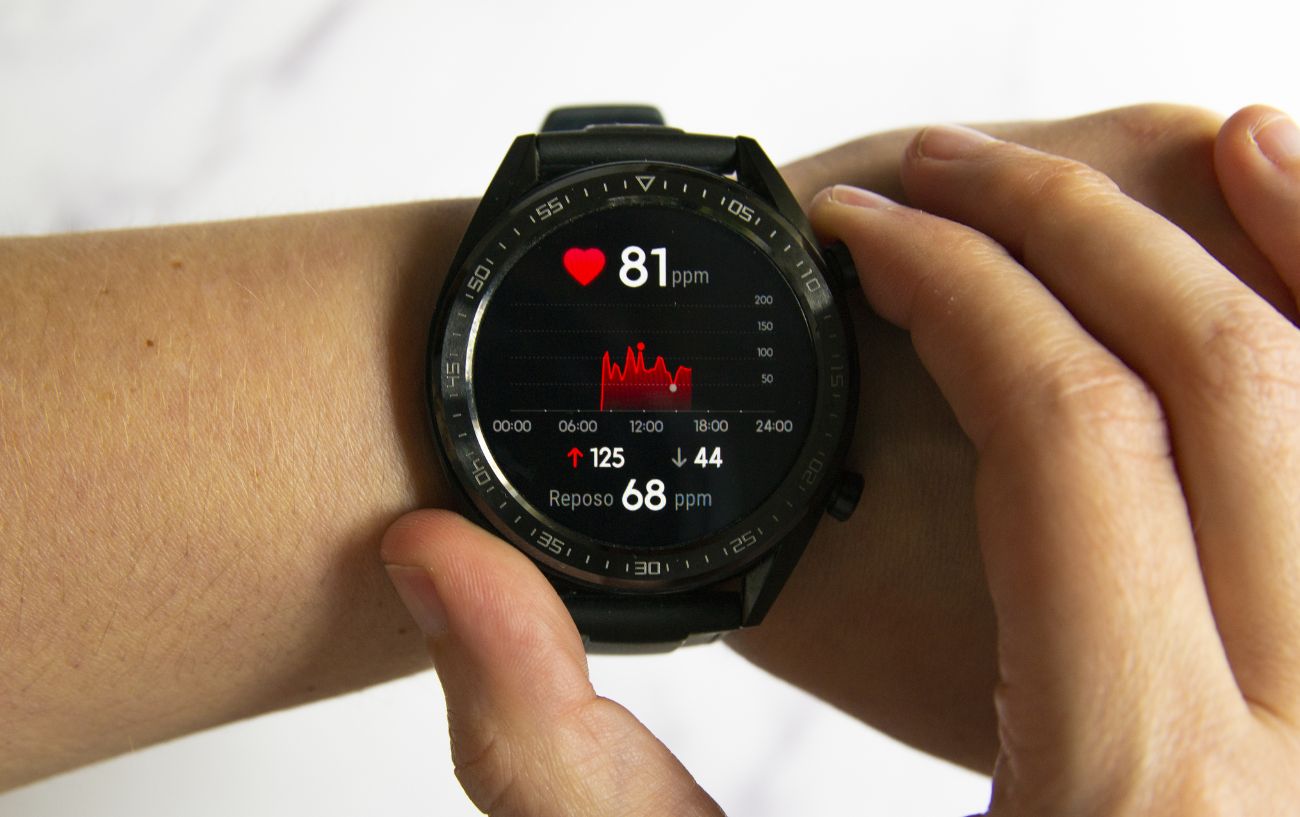Because keeping tabs on measurable variables can provide insight into your training status and fitness, athletes often pay close attention to biometrics such as blood pressure, body fat percentage, and resting heart rate.
Another key heart-related biometric is your heart rate variability or HRV. HRV is a measure of the differences or fluctuations in the length of time between each successive heartbeat.
With more and more fitness watches now offering the ability to measure your heart rate variability, competitive athletes and recreational athletes alike are starting to pay more attention to this biometric.
In most cases, a higher heart rate variability is a good thing, as it means your body can adapt quicker to different situations and stimuli. It is also correlated with improved mental health. In healthy adults, heart rate variability is between 19 and 75 milliseconds.1King, L. M., & PhD. (n.d.). What Is Heart Rate Variability? WebMD. Retrieved July 23, 2024, from https://www.webmd.com/heart/what-is-heart-rate-variability#1-4
However, it should be closely noted that heart rate variability is a metric that is difficult to assess. What is considered a healthy heart rate variability value varies with age, and a healthy value for one person may not be a healthy value for another.
If you want to properly understand your heart health and heart rate variability, you should go to a doctor or medical professional for HRV monitoring, who will measure it using an electrocardiogram, rather than attempt to self-assess it through a wearable fitness device.2Cleveland Clinic. (2021, September 1). Heart rate variability (HRV): what it is and how you can track it. Cleveland Clinic. https://my.clevelandclinic.org/health/symptoms/21773-heart-rate-variability-hrv
In fact, in some instances, a higher heart rate variability metric can actually be a result of heart problems.3Shaffer, F., & Ginsberg, J. P. (2017). An Overview of Heart Rate Variability Metrics and Norms. Frontiers in Public Health, 5(258). https://doi.org/10.3389/fpubh.2017.00258
However, with this in mind, in this article, we will explore several evidence-based methods to improve your heart rate variability healthily. The methods are centered around improving both physical health and mental health, as HRV is significantly linked with both.

How to Increase HRV
Here are some of the best tips for how to increase heart rate variability if you have low HRV or if you would simply like to try and improve your current HRV:
#1: Improve Your Sleep Habits
If you find yourself saying, “My HRV is very low,“ probably the single best thing you can do to improve your HRV is to focus on trying to get better sleep.
Not only do you need to be getting enough sleep every night, but you also need to get high-quality, restful, restorative sleep on a consistent basis, to allow for a consistent circadian rhythm.
According to the National Sleep Foundation, adults should aim to get 7–9 hours of sleep every night for optimal health.4Hirshkowitz, M., Whiton, K., Albert, S. M., Alessi, C., Bruni, O., DonCarlos, L., Hazen, N., Herman, J., Adams Hillard, P. J., Katz, E. S., Kheirandish-Gozal, L., Neubauer, D. N., O’Donnell, A. E., Ohayon, M., Peever, J., Rawding, R., Sachdeva, R. C., Setters, B., Vitiello, M. V., & Ware, J. C. (2015). National Sleep Foundation’s updated sleep duration recommendations: final report. Sleep Health, 1(4), 233–243. https://doi.org/10.1016/j.sleh.2015.10.004
Note that athletes in training may need even more sleep to optimize HRV, recovery, and overall health and well-being.

Implementing good sleep hygiene practices is important to help improve both the quantity and quality of your sleep, to ensure you’re getting full sleep cycles with quality deep sleep and REM sleep.
This includes things like:
- Keeping a consistent sleep schedule and bedtime routine
- Staying away from screens and blue light for at least one to two hours before bed
- Stopping caffeine intake at least six hours before bed
- Avoiding excess alcohol consumption and heavy meals
- Keeping your bedroom cool and dark
- Using a white noise machine
While many people feel like they can get away with less sleep, if you are truly invested in increasing heart rate variability, focusing on getting the best sleep you can consistently is the single best strategy for increasing HRV and well-being.
#2: Implement Breathwork
The majority of people who are trying to improve low heart rate variability are those who take an interest in their overall health and wellness practices.
For this reason, many may already be familiar with the practice of breathwork, making it easier to get on board with incorporating this wellness strategy into their “low HRV treatment plan“.

You don’t have to turn into a diehard yogi or sit on a meditation cushion for countless hours a day doing diaphragmatic breathing to see improvements in HRV and nervous system regulation with breathwork exercises.
In fact, research has found that slow, deliberate deep breathing for just six minutes a day can increase parasympathetic nervous system activity.5Russell, M. E. B., Scott, A. B., Boggero, I. A., & Carlson, C. R. (2016). Inclusion of a rest period in diaphragmatic breathing increases high frequency heart rate variability: Implications for behavioral therapy. Psychophysiology, 54(3), 358–365. https://doi.org/10.1111/psyp.12791
This, in turn, will help increase your HRV, as you will see more heart rate variability when your parasympathetic nervous system is activated.
Your parasympathetic nervous system is the part of your autonomic nervous system responsible for resting, relaxing, and digesting. It is the counterpart to your sympathetic nervous system, which is linked to your fight-or-flight response and anxiety.
When you do breathing exercises to increase heart rate variability, try to take at least 10 seconds per breath so that you are breathing no more than six times per minute.
Use diaphragmatic breathing, or belly breathing, so that the air fully distends your belly rather than just filling your chest.
Try to breathe in for at least four seconds, hold for a count of two, and then slowly exhale for four seconds.
Another great thing about using breathwork as a strategy to increase heart rate variability is that you can call upon this skill at the moment when you are experiencing lower HRV symptoms such as anxiety.
In this way, this “low HRV hack” can be both an ongoing strategy to help with low heart rate variability and an acute “rescue trick“ for times in the day when your sympathetic nervous system is overrunning your parasympathetic nervous system.
Breathwork is closely linked with, or could even be considered a part of, a treatment known as biofeedback training, which is used to improve HRV and improve mental health.6Frank, D. L., Khorshid, L., Kiffer, J. F., Moravec, C. S., & McKee, M. G. (2010). Biofeedback in medicine: who, when, why and how? Mental Health in Family Medicine, 7(2), 85–91. https://www.ncbi.nlm.nih.gov/pmc/articles/PMC2939454/

#3: Work Out Consistently
We know that getting regular exercise is important for overall health, so it is probably not surprising that there is evidence to suggest that both strength training and aerobic exercise can improve your heart rate variability in a meaningful way.7Phoemsapthawee, J., Prasertsri, P., & Leelayuwat, N. (2019). Heart rate variability responses to a combined exercise training program: correlation with adiposity and cardiorespiratory fitness changes in obese young men. Journal of Exercise Rehabilitation, 15(1), 114–122. https://doi.org/10.12965/jer.1836486.243
Therefore, if you have low heart rate variability and you are relatively inactive or inconsistently active with your workout routine, you should focus on building a habit of getting enough exercise on a regular basis and improving your physical fitness.
For those who find themselves concerned with the question, “Why is HRV so low?” make sure that, at the very least, you are meeting the recommendations for physical activity for adults set forth by the Centers for Disease Control and Prevention and the British Heart Foundation.8Understanding physical activity. (2022). Bhf.org.uk.
These are to accumulate either 150 minutes of moderate-intensity aerobic exercise or 75 minutes of vigorous-intensity cardio exercise per week and two full-body strength training workouts per week.

#4: Don’t Overdo It On Exercise
While failing to get enough exercise can contribute to low HRV because it can compromise your overall health and your ability to mitigate stress, the opposite is also true.
Overtraining or exercising too vigorously, too long, or without adequate recovery time puts your body in a state of overstress. This will increase cortisol and sympathetic nervous system activation, which will cause very low HRV.
Indeed, studies have found that overtraining can lead to a chronic imbalance in nervous system activity, with the sympathetic nervous system dominating the parasympathetic nervous system.9Rabbani, A., Clemente, F. M., Kargarfard, M., & Chamari, K. (2019). Match Fatigue Time-Course Assessment Over Four Days: Usefulness of the Hooper Index and Heart Rate Variability in Professional Soccer Players. Frontiers in Physiology, 10. https://doi.org/10.3389/fphys.2019.00109
Over time, this will decrease your heart rate variability and lead to low HRV numbers.
Pay attention to your body for signs of overtraining; they often overlap the symptoms of low HRV and include things like fatigue, difficulty sleeping, poor sleep quality, poor recovery from workouts, and low energy even after sleeping.
Using exercise as a tool to increase heart rate variability and improve overall health is contingent upon finding a good balance between getting enough aerobic and resistance training exercises while supporting your body‘s recovery.

#5: Get Outside
Connecting with nature can be a great tip on how to improve HRV.
Studies have found that forest walking rather than city walking is much more effective at improving symptoms and physiological markers of stress, including reducing blood pressure and cortisol levels.10Park, B. J., Tsunetsugu, Y., Kasetani, T., Kagawa, T., & Miyazaki, Y. (2009). The physiological effects of Shinrin-yoku (taking in the forest atmosphere or forest bathing): evidence from field experiments in 24 forests across Japan. Environmental Health and Preventive Medicine, 15(1), 18–26. https://doi.org/10.1007/s12199-009-0086-9
Thus, trying to get out in nature is a great strategy for increasing HRV naturally.11Lee, J., Park, B.-J. ., Tsunetsugu, Y., Ohira, T., Kagawa, T., & Miyazaki, Y. (2011). Effect of forest bathing on physiological and psychological responses in young Japanese male subjects. Public Health, 125(2), 93–100. https://doi.org/10.1016/j.puhe.2010.09.005
#6: Try Yoga
Although all exercise could be helpful for improving heart rate variability, yoga has independently been found to help increase heart rate variability in healthy adults.12Papp, M. E., Lindfors, P., Storck, N., & Wändell, P. E. (2013). Increased heart rate variability but no effect on blood pressure from 8 weeks of hatha yoga – a pilot study. BMC Research Notes, 6(1), 59. https://doi.org/10.1186/1756-0500-6-59
Certain types of meditation are also a great way how to improve HRV, such as Acem meditation.13Anders Nesvold, Morten W Fagerland, Svend Davanger, Øyvind Ellingsen, Erik E Solberg, Are Holen, Knut Sevre, Dan Atar, Increased heart rate variability during nondirective meditation. (2012). European Journal of Preventive Cardiology, Volume 19, Issue 4. Academic.oup.com. https://academic.oup.com/eurjpc/article/19/4/773/5928142

#7: Focus On Hydration
An often-overlooked cause of poor HRV values is dehydration.
Proper hydration status seems imperative for all aspects of optimizing your health and well-being, and it also can positively affect HRV.
For example, a clinical study found that even mild dehydration caused a decrease in heart rate variability in both men and women.14Young, H. A., Cousins, A., Johnston, S., Fletcher, J. M., & Benton, D. (2019). Autonomic adaptations mediate the effect of hydration on brain functioning and mood: Evidence from two randomized controlled trials. Scientific Reports, 9(1). https://doi.org/10.1038/s41598-019-52775-5
Dehydration is a stressor on the body, which can key up more sympathetic nervous system activation because the entire cardiovascular system has to work harder to supply your body with enough oxygen because blood volume drops when you are dehydrated.
This means that your heart has to beat faster in order to pump enough volume of blood per minute to your tissues.
Moreover, the aforementioned study found that mild dehydration contributed to heightened anxiety, lower mood, and poor cognitive function.
Anxiety can cause HRV to drop even more because it further activates the sympathetic nervous system and causes an imbalance in your nervous system regulation.
According to the U.S. National Academies of Sciences, Engineering, and Medicine, women should aim to drink around 11.5 cups of fluid per day, and men should shoot for 15.5 cups.15(2020). Nationalacademies.org. https://www.nationalacademies.org/news/2004/02/report-sets-dietary-intake-levels-for-water-salt-and-potassium-to-maintain-health-and-reduce-chronic-disease-risk
Your own hydration needs may differ depending on your activity level, body size, climate, and workout routine, but making sure that you are getting enough water and staying properly hydrated is a great tip for how to improve heart rate variability.

#8: Limit Alcohol Consumption
Alcohol is perceived as a toxin to the body, so it functions as a stressor.
You do not have to eliminate alcohol entirely if you have low HRV or are looking for how to increase HRV naturally, but you do want to make sure that you are not drinking in excess.
One study found that one glass of wine did not impact HRV, but having two glasses of wine decreased heart rate variability by 28 to 33%.16Spaak, J., Tomlinson, G., McGowan, C. L., Soleas, G. J., Morris, B. L., Picton, P., Notarius, C. F., & Floras, J. S. (2010). Dose-related effects of red wine and alcohol on heart rate variability. American Journal of Physiology-Heart and Circulatory Physiology, 298(6), H2226–H2231. https://doi.org/10.1152/ajpheart.00700.2009
This is rather significant, and worse, experts suggest that the HRV-lowering effects of alcohol may last for several days.
#9: Increase Your Green Vegetable Intake
We always hear the health advice, “Eat more greens!“
And studies suggest that if you want to know how to improve heart rate variability, this sage nutrition advice applies here as well.17Home Page: The American Journal of Clinical Nutrition. (n.d.). Ajcn.nutrition.org. https://ajcn.nutrition.org/
One study found that people who ate more cooked or raw leafy green vegetables such as spinach, kale, mustard greens, and dark lettuce had higher HRV scores than those who did not.
Interestingly, other aspects of what is generally considered to be a healthy diet, such as consuming more fish and fruit, did not impact HRV numbers in a statistically significant way.
So, harness your inner Popeye and add more leafy greens when you are trying to raise your HRV number.

#10: Cut Your Commute
If possible, cutting back your commute or looking into other ways to strike a better work-life balance is another great tip to help fix low heart rate variability.
Studies have found that a long commute—90 minutes or more—reduces HRV.18KAGEYAMA, T., NISHIKIDO, N., KOBAYASHI, T., KUROKAWA, Y., KANEKO, T., & KABUTO, M. (1998). Long Commuting Time, Extensive Overtime, and Sympathodominant State Assessed in Terms of Short-Term Heart Rate Variability among Male White-Collar Workers in the Tokyo Megalopolis. INDUSTRIAL HEALTH, 36(3), 209–217. https://doi.org/10.2486/indhealth.36.209
#11: Use a Gratitude Journal
It may sound like just another woo-woo health tip, but studies have found that the act of writing in a gratitude journal actually raises HRV while the activity is taking place.19Redwine, L. S., Henry, B. L., Pung, M. A., Wilson, K., Chinh, K., Knight, B., Jain, S., Rutledge, T., Greenberg, B., Maisel, A., & Mills, P. J. (2016). Pilot Randomized Study of a Gratitude Journaling Intervention on Heart Rate Variability and Inflammatory Biomarkers in Patients With Stage B Heart Failure. Psychosomatic Medicine, 78(6), 667–676. https://doi.org/10.1097/psy.0000000000000316
Just jotting down a few things that you are grateful for can have a profound effect on your mood and nervous system regulation.
Overall, if you are serious about treating low heart rate variability, stress management should be at the forefront of your “low HRV treatment plan.“
Final Thoughts
For more information about decreasing stress levels to better your HRV, check out our article on the benefits of smiling here.













